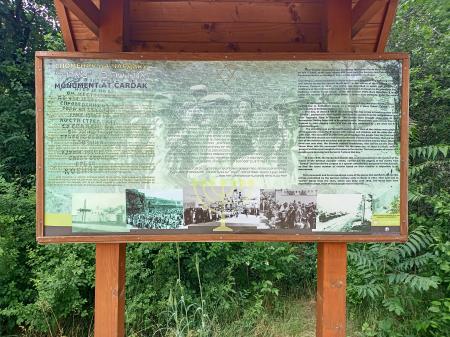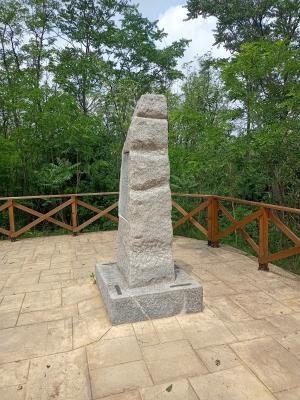Obj. ID: 49998
Memorials Memorial to the Jewish Victims at the Cardak Killing Site in Deliblato, Serbia, 1955

Memorial Name
Monument to the Jews Shot in the Deliblato Sands
Who is Commemorated?
The 430 Jewish victims shot at this spot in Deliblato on October 9, 1941.
Description
The monument is made of greyish stone and has an amorphous, natural form. It has the shape of an upright marker standing on a narrow base. On the front side, it features an engraved fallen leaf and a plaque with an inscription in Serbo-Croatian. On the backside is a plaque with an engraved Magen David on top, a Menorah at the bottom, and an inscription in Hebrew.
Nearby is an informational sign that contains the historical narrative in Serbo-Croatian, Hebrew, and English.
Inscriptions
Stele Front (Serbo-Croatian)
9. октобра 1941 год. окупатор је на овом месту стрељао 430 Јевреја спроведених из
логора на Бањици. Јуна 1944. год. кости стрељаних су спаљене да би уништили трагове свога злога злочина.
7. јула 1955. г.
Савез бораца среза Ковинског
Translation: On October 9, 1941, the occupier shot 430 Jews from the camp in Banjica. In June 1944, they burned the bones of the shot in order to destroy the traces of their evil crime. / July 7, 1955 / The Association of Fighters of the Kovin County
Stele Back (Hebrew)
במקום זה
בתאריך
9 באוקטובר 1941
הכובש הוציא להורג
430 יהודים אשר הובאו
מהמחנה "באניצה".
בחודש יוני 1944
עצמות הקורבנות נשרפו
על מנת להשמיד את
הראיות של פשעיו.
7 ביולי 1955
איגוד הלוחמים של מחוז קובין
Translation: In this place, on October 9, 1941, the occupier executed 430 Jews who were brought from the Banjica camp. In June 1944 the bones of the victims were burned in order to destroy the evidence of their crimes. / July 7, 1955 / The Association of Fighters of the Kovin County
Informational Sign
Serbo-Croatian
[To be transcribed]
Hebrew
האנדרטה ב-"צ'ארדק" הוקמה בתאריך 7 ביולי 1955 ע"י איגוד הלוחמים של מחוז קובין,
במקום שבו בתאריך 9 באוקטובר 1941 הכובשים הגרמנים הוציאו להרוג 430 יהודים ממחנה
ריכוז "באנייצה", כפי שרשום באנדרטה.
על פי מחקר שפורסם בספר "הרגיות בפאנצ'בו ויאבוקה במהלך מלחמת העולם השנייה," מאת
ד"ר איוונה ספסוביץ' והוצא לאור בשנת 2011 ע"י הארכיון ההיסטורי בפאנצ'בו, הפשע תואר
בפרטי פרטים ועל פי עדויות אשר ניתנו לועדת חקירה לפשעי מלחמה בבנאט, ע"י העדים סטבן
מאג'ראץ, יערן גושי, תחת מס' 1937 ובטאק מילן, חקלאי מדליבלאט, תחת מס' 1935.
בתחילת אוקטובר 1941 בוצע ירי המוני לרוב ביהודים, בחולות דליבלאט, ביער "צ'ארדק"
במחוז דליבלאטו. יום אחד בסביבות השעה 8 בבוקר, הובאו חמש משאיות גדולות, מלאות
בגברים, נשים וילדים, לרוב מהמחנה ב"Topovske supe" בבלגרד למקום שנקרא
"צ'ארדק". הקורבנות הובאו יחד עם כל חפציהם מכיוון שנאמר להם כי הם הולחים לעבוד. מיד
עם הגעתם נצטוו לחפור בורות. עבודה זו הסתיימה עד השעה 13, כאשר התחיל הירי. הקורבנות
הוצבו בשלוש שורות: בשורה הרישונה נשים וילדים ובשתי השורות האחרות גברים. קודם נורו
העומדים בשורה הראשונה, כאשר אלו מהשורה השנייה חויבו לזרוק את הגופות מהשורה
הראשונה לבורות; אז נורו הקורבנות מהשורה השנייה ואלו מהשורה השלישית זרקו אותם
לבורות. כאשר נורו גם הקורבנות מהשורה השלישית, החיילים אשר ביצעו את הירי זרקו
בעצמם את גופותיהם לבורות שנחפרו. באותו יום בסביבות השעה חמש, הובאה קבוצת
קורבנות נוספת, בחמש משאיות. ביום זה נורו בסביבות 500 בני אדם אשר נקברו ב-7 בורות.
בחודש יוני 1944 זונדרקומנדו 150, יחידה המתמחה בהשמדת ראיות של פשעי הכובש
הגרמני, הוציאה את קורבנות צ'רדאק מהבורות ושרפה את גופותיהון במשרפה מיוחדת אשר
נבנתה במיוחד למטרה זו, כך שעל סמך שרידי הגופות לא ניתן לקבוע את מספר הקורבנות
המדויק.
אנדרטה זו ויסביבתה היא אחד המקומות המעידים על הפשעים הנוראים שביצעו יחידות גרמניות
בשנת 1941 בבנאט. המטרה היתה "לנקות" את בנאט מיהודים, והיא הושגה עד שנת 1942.
יהודי בנאט גורשו למחונות, ורובים מעולם לא חזרו מהם...
English
The "Cardak" monument was erected by the Kovin County Federation of Soldiers
on July 7, 1955, at the place where 430 Jews from the Banjica camp were shot by the
German occupiers on October 9, 1941, as the monument text says.
According to a study published in a book by Dr Ivana Spasovic "The Suffering in Pancevo
and Jabuka during the Second World War", in the edition of the Historical Archive of
Pancevo, Pancevo in 2011, this crime was described in detail, and based on the
testimony of the Criminal Investigation Commission In Banat, by the witness Stevan
Madarac, a senior forest ranger, under the number 1936, Dura Nedeljkov, a farmer,
under the number 1937 and Milan Batak, a farmer from Deliblato, under the number
1935.
"At the beginning of October 1941, a massive firing execution mostly of Jews was
carried out in Deliblatski pesak, in a forest at a place called "Cardak", in the
municipality of Deliblato area.
One day, at about 8 AM in the morning, five big lorries arrived in a place called
"Cardak", packed with men, women and children, mostly from the concentration camp
near Topovske supe in Belgrade. The victims were brought along with all their
belongings, having been told to be going to work. Immediately upon arrival, they were
ordered to start digging holes and this job was completed by 1 pm when the firing
execution began.
The shooting was performed in such manner that all victims were placed in
three separate rows: the first one with women and children, and the other two rows
with men. The execution started with gunning down the people from the first row and
those from the second row had to throw the shot victims into the holes; then the second
row of the victims was executed, and the third row threw them into the holes. When the
third row was shot, the German soldiers themselves, who carried out the shooting,
threw them into the excavated holes. On the same day, at about 5 o'clock, another
group of victims was brought to this place in five lorries. The total number of around 500
people were executed and buried in 7 pits on that day."
In June 1944, the Sonderkommando 150, a unit specializing in the removal of the
traces of the German occupier crimes, carried out the digging of the victims from
"Cardak" and burned the corpses in a special crematorium, designed for that purpose,
so that the exact number of victims based on their remains is impossible to be determined.
This monument and its surroundings is one of the places that testifies to the terrible
crimes committed by the German military units in Banat in 1941. Their goal was to
"purify" Banat from the Jews, which was done until 1942. The Banat Jews were
deported to camps, most of those people never returned ....
Commissioned by
The Association of Fighters of the Kovin County
sub-set tree:
Deliblato is a village in the municipality of Kovin, in the south Banat District. During World War II, the area around the village – the Deliblato Sands, was a training ground for the 7th volunteer SS Division "Prince Eugen", composed of the local German population. The murder that took place at this site is described in a report by a German officer who commanded the shooting and in the statements of several witnesses.
Jews from the Banat region in Vojvodina were deported by the Volksdeutsche to Belgrade in the summer of 1941. Men were interned in the nearby Topovske Šupe Concentration Camp, located in a former military compound. Although predominantly Jewish, in the camp were incarcerated also Roma and Serbs. On October 9, 1941, 180 Jewish inmates were taken to Deliblato Sands and murdered under the command of Oberleutnant Walter Liepe. Two days later, another 269 Jewish inmates were shot in the nearby village of Jajinci. Victims were stripped of their valuables on-site and shot in small groups. In June 1944, special German units were ordered to remove the traces of this crime and carried out the exhumation and incineration of the bodies of murdered Jews.
The monument in Deliblato was unveiled on July 7, 1955, on the occasion of commemorating the 14th anniversary of the uprising in Serbia. The Association of Fighters of the National War of Liberation of Kovin County initiated the erection of the monument.
Even though modest in size and with the inscription not entirely coherent with historical facts, this Holocaust memorial is of particular importance since it marks the site of the first mass murder of Jews in Serbia, which was declared judenfrei (free of Jews) already in August 1942. The monument is also among the first public memorials commemorating the Yugoslav Jewish victims of World War II, whose erection was initiated by the Yugoslav state organs.
After the political changes of the 1990s, the annual ceremonies commemorating the victims have halted at this site. The memorial has been for a long time forgotten, although the local Association of Fighters of the National War of Liberation, published a report in 2013 with a request to put signposts to the site and clean the area around it. After many years of appeals by the Jewish Community of Pančevo to state institutions and media, in 2018 state funds were secured for the reconstruction of the monument. The reconstruction of the monument was completed in March 2018. After almost three decades, a commemoration ceremony, organized by the Jewish Community of Pančevo, was held at the site on Yom HaShoah - the Holocaust Remembrance Day - on March 12, 2018.
"Memorials in Deliblato," Locations (Vojvodina Holocaust Memorials Project), https://www.vhmproject.org/en-US/Locations/Memorials/11 (accessed June 11, 2023)
“Deliblato,” Killing sites: The First Stage of the Holocaust in Serbia and Croatia, http://ksites.digitus.mystableservers.com/deliblato/ (accessed June 11, 2023)
“Memorijalna komisija,” Makabijada, http://makabijada.com/jopancevo/hk.htm (accessed June 11, 2023)












